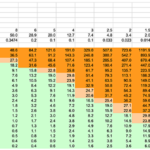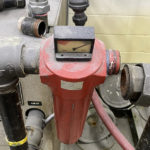
A large mine had a compressed air assessment done to gauge the efficiency of its system. The complex had more 14 large air compressors feeding underground operations. The assessment results showed their many compressors were running at superior efficiency; in fact, the numbers were so good they could not possibly be true.
In previous years, another study was done — and a number of well-placed flow meters were installed to measure the system air flow, including the main output of each set of compressors. These meters were used in the calculation of the system specific power.
Specific poser is a number not unlike a gas mileage indicator. If the total power consumed by the system is divided by the number of hundred cubic feet measured by the flow meters, the result can be used to determine how efficiently any compressed air system is producing compressed air. A good reading for large compressors is under 18 kW per 100 cfm, while a bad reading would be anything higher than 20 kW per 100.
This particular mine had big problems with compressor cooling in the summertime. Most of the large screw compressors were air cooled units, and the few liquid-cooled compressors had been converted to glycol to air coolers. Many of the coolers had become fouled with road dust kicked up by large mine trucks that passed by the air compressors every day. Anytime the ambient temperatures got hotter than about 60° F, the output of the compressors reached about 80° F or hotter.
Further to this, the mine had no air dryers — the discharge of the air compressors was totally saturated with water, so large amounts of water condensed out in the piping system. And this caused trouble with the system flow meters, because the meter type installed was thermal mass style.
Thermal mass flow meters measure the flow of air though a cooling effect. A heated probe is inserted in the stream of compressed air, which cools the tip. The power required to keep tip at constant temperature is measured and is directly proportional to the flow of air past the measuring probes. This works very well if the compressed air is dry, however, with wet and saturated air the flow meter will read high or even off scale.
The selected flow meters were the wrong style to be used in this situation. The assessment that deemed the air compressors very efficient was relying on faulty data. When careful measurements were done by a seasoned auditor, the results were not good. The system was extremely inefficient, with some compressor consuming 80% power, yet only producing 20% flow. Of the 14 compressors, only two were producing full flow. The capacity output was so bad, the mine had resorted to renting a fleet of six diesel portable compressors just to keep up!
Measurement of compressed air power and flow is important, but careful attention needs to be given to the measurement methods. Faulty data leads to faulty conclusions as it did in this case. Correct measurement (and some timely training) would have told system operators their compressors were at low capacity and would have saved more than $1,000,000 per year in rental and fuel costs!





Leave a Reply